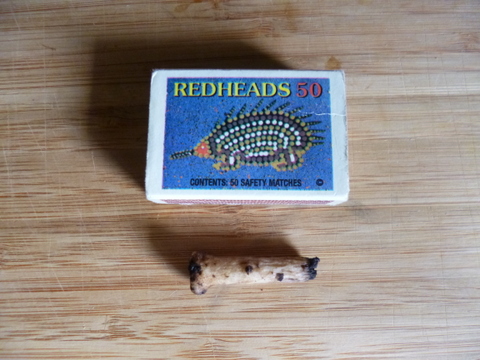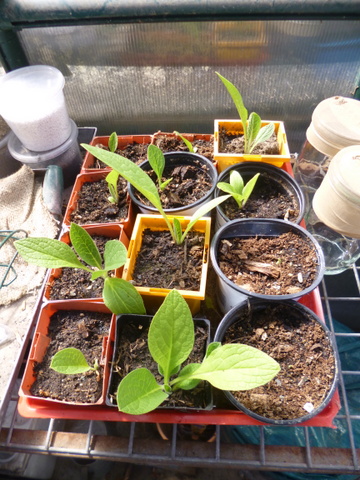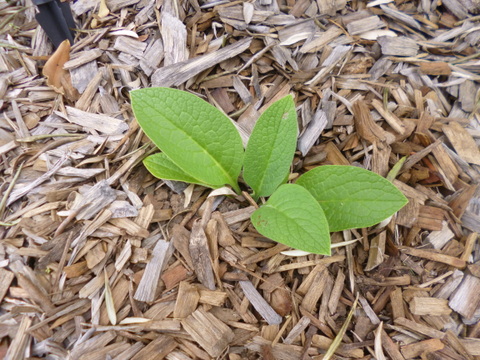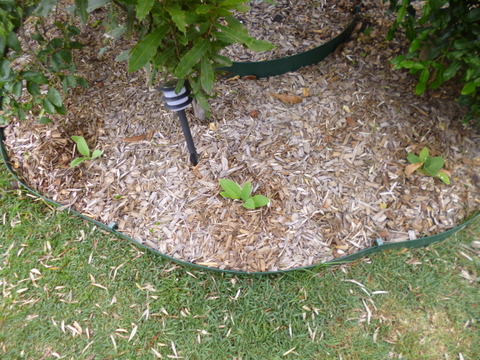Comfrey is wonderful stuff! It has long roots which mine the soil deeply for minerals, so deep that other plants can’t reach, and then these minerals become available for other plants once the leaves are harvested for mulch or fertiliser. The leaves are rich in calcium, phosphorous, potassium and trace elements. The leaves are also rich in vitamins A and C and it is apparently the only land plant which contains vitamin B12. Small amounts of the young leaves can be eaten raw in salads or cooked like spinach. It is a herb which has many miraculous properties attributed to it but I have neither the qualifications nor experience that would enable me to comment on these claims.
The flowers are excellent bee forage and the plants themselves can be planted thickly to act as a barrier to running grass type weeds. The deep root system can impact on the soil structure positively as well, breaking up compacted soils.
My interest in the comfrey leaves stems from their ability to improver fertility in the garden. They can be used as a rich mulch or their nutrients extracted in the form of a liquid manure (covered in a different article). I have been developing plans for the understory of the food forest area, the fruit tree circle and other tree plantings which included comfrey as an understory plant. They would provide extra nutrients for the trees as well as allowing me to make the comfrey liquid manure from the leaves to use on the vegetable garden. Lots of comfrey leaves to use as high nutrient mulch would not go astray either!
Propagating Comfrey
Comfrey is notoriously unreliable to start from seed but is generally propagated from crown cuttings and by root cuttings. Root cuttings is usually the cheapest way and I was able to get hold of 25 root cuttings for $19.95 from Green Harvest but when I factored in postage it work out to a bit over $1 per cutting.
I got hold of 25 roughly 120mm diameter pots which I had floating around. This size pot is usually the sort that is used to house “potted colour” and other small ornamentals and when they have been planted out the pot quite often gets put to one side and forgotten or tossed out. They are usually available for the asking from friends and family and I have even seen collections of them stuck out on the footpath during rubbish collection days so you should be able to pick them up for nothing.
The containers I used were about 90mm deep and the information which came with the cuttings said they should be planted 30mm deep and kept moist until the first leaves appeared. The information said to plant the root cuttings in spring in cool areas or in the wet season in warmer areas. We have a greenhouse so I planted them as soon as I got them, or in other words about mid-winter.
I made up some potting mix and half-filled each of the pots, placed a cutting horizontally into the pot (the cuttings were 25-30mm long so fitted easily) and then filled in the rest of the potting mix. I then watered each of the pots well to firm down the soil around the cuttings and to keep them moist. To make sure they stayed moist I place all of the pots onto capillary beds. A capillary bed is a tray (in this case an unused cat litter tray) with 50mm or so of coarse sand in it. The sand is kept moist and acts as a reservoir of water which makes its way up into each if the pots by capillary action, hence the name!
To fit all the pots I needed two trays, with one pot left over, which went into the seedling capillary bed. It was fun checking the pots every couple of days to see how many had sprouted. It took a few weeks for the first one and then they gradually came up over time. It has been almost 3 months now and all but 4 of the cuttings have sprouted giving a strike rate of just over 80% which seems pretty good to me.
I am now in the process of planting out my newly sprouted comfrey roots into the longitudinal food forest and I have planted one between each of the trees in the fruit tree circle and still have a few left over to slip in here and there. This method is cheap, easy and quite reliable if you are after quite a few comfrey plants…..even I could do it!







